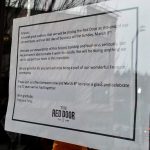by Kirby Lindsay Laney
originally posted 10 October 2012

This column is re-posted as the Red Door closed on March 8th, 2020, just before the forced closure of all Fremont businesses due to COVID-19 pandemic directives. The closure was a decision of the owners after much consideration. Based on what came next, they might be seen as prescient. However, the closure does draw to an end a noble history, much of it detailed here.

“Good times are back at the Fremont and Fat City Taverns, following Health Department permission to re-open on August 6th. A lot of repairs preceded the effort, and the smell of fresh paint and detergents still hangs in the air. The rodent problem, which appears to have been exaggerated in the first place, is completely licked… Rumor holds that this business about “severe rodent infestation” was a fabrication fed to the H.D. by a disgruntled former employee, and that he later admitted to such.”
– from ‘The Gossip Box,’ published September 1982, as a feature in The Fremont Forum newspaper.
No accurate, historical nickname exists for the building that originally housed the Fremont Drug Co, the Fremont Tavern and, today, the Red Door. Not only have the occupants changed over the 100 plus years of the structure’s existence, but its address has also changed, at least once. Currently, the building proudly stands at 3401 Evanston Ave N, one block west of where it formerly served as a gateway to Fremont – at 3401 Fremont Ave N.

(One Of) Fremont’s Oldest Existing Building
In the ‘Historical Survey and Planning Study of Fremont’s Commercial Area’ compiled by Carol Tobin in 1991, the building still stood sentry on Fremont Ave. Tobin noted the “simple, wood-frame, turn-of-the-century commercial building,” dated “from 1895 (according to DCLU records) or about 1900 (according to Assessor’s records.)”
Tobin also noted, in the opening information of the Survey (which is available for reference on the Fremont shelf at the Seattle Public Library Fremont Branch,) that the “Fremont Drug Company/Red Door Ale House” is “Fremont’s earliest extant building.” In her book, “Images of America: Seattle’s Fremont,” author Helen Divjak also described this as “Fremont’s oldest existing building.”

At least one other structure in Fremont pre-dates 1895 – B.F. Day School – but a rumor persists that this building actually moved to 3401 Fremont Ave N from elsewhere, and may have been constructed earlier. Divjak wrote, “In the 1890’s, a team of oxen moved it from its original location across the would-be canal to its address here at Fremont Avenue…” Yet in the Survey, Tobin noted, “Fremont lore suggests that the building was moved from across the street, but no evidence of this was found.”
Tobin did give one fact that supports an earlier existence of the building – she described the Fremont Drug Co. as being “located at this site from 1893 until 1911.”
A Major Remodel

While the Fremont Tavern has the longest history in the building (from mid-1930s to the mid-1980s) many other businesses have also operated in this structure, including the Metropolitan Hotel (1918 – 1923,) Metropolitan Café (1923 – 1932,) the Pastime Cigar Store, A&E Café, Chuckanut Charlie’s, Poor Richard’s Saloon, the Too High Tavern (1971.) This was also the original location of The Dubliner Pub, now located at 3517 Fremont Ave N. Fremont legend places a Prohibition-era brothel on the second story, although in the 1980s, the second floor had a collection of artist’s studios.
Suzie Burke, president of the Fremont Dock Company, bought the building in 1985 or 1986. In 1988, the building underwent what Tobin described as a “major remodel,” including converting the upstairs into office space and the former Fremont Tavern into the Red Door.

Fremont architect George Heideman did the design for Red Door owner Alfa Zinkus who completely refreshed the space, while respecting the history he’d inherited. The remodel repaired many decades of damage and delayed maintenance but it also included, according to Tobin, restoration of the back bar from the Fremont Drug Co, and installation of a “stained glass transom” above the main entrance.
Another Major Remodel
In 2001, Fremont Dock Company leased the property along N 34th St from Fremont Avenue to Evanston Ave to Security Properties for development. The two other buildings on the property were demolished, but the developer paid to have ‘the Red Door’ moved one block west.

According to a press release from Muir Public Relations, the decision to move the building “cost Security Properties several months of delay and a substantial amount of money.” In the release, Security Properties Vice-President, John Marasco, is quoted, “…we agreed to pay for the move, provided the Red Door stay in central Fremont.”
Fremont Dock Company did have available an empty lot one block west where U-Park System managed a public parking lot, and the Fremont Sunday Market placed overflow vendor booths. The company had also hosted the Lenin statue here when it initially arrived in Fremont, in 1995.
The relocation of the building meant another, even more extensive remodel – and allowed the Red Door to take over the entire main floor. Greg Bjarko, of Bjarko-Serra Architects, designed the portions of the project related to the Red Door including the front staircase, the deck, and the way the building would be seated. Pankow did design/build of the concrete pedestal that now supports the building, and the elevator shaft located behind the building that provides A.D.A. access to the second-floor office space and three-floors of subterranean parking and storage.
Today, U-Park still manages the parking here – two floors of it – and the Fremont Sunday Market uses the first floor parking lot (P1) for its year-round, indoor flea market.
On The Move (& The Earthquake)
Of course, moving a structure is more than finding a location and funding, as this relocation would prove. For one thing, as the contractors and movers prepared the building for its historic stroll, one block west, they discovered some previously hidden damage within the structure.
As they inserted supportive steel beams beneath the structure, the north wall broke. An inspection revealed that a long-ago fire had severely weakened supports in that wall, and the supports bent when the movers shored up the building. So the building was trussed with cables and prematurely suspended to a crane while the extent of the damage was assessed.
Four men stood on the roof, inspecting the new supports, on February 28th, 2001. According to eyewitness reports, when the Nisqually earthquake struck Seattle at 10:54a that morning, the building swung once to the north, returned to center, swung a second time north, and settled again. The anecdote continues that the men sank to their rears, cautiously slid across the roof and crawled down the staircase to clear the area – as fast as they could safely scoot – and that at least one promptly resigned from the job.
It is possible that if the building had not been trussed with cables and steel when the earthquake struck, it would have collapsed in a pile of wooden shards. Yet, the earthquake and the City permitting process did delay the project, and it was not until June 3rd, 2001 that one of Fremont’s oldest buildings crossed Evanston Avenue North.
On The Changes
The ‘Fremont Tavern’ building continues to endure as the ‘Red Door,’ and after 24 years it is apparent that the neighborhood has embraced the ‘new’ business as much as the old. Yet, accepting change gracefully – even the inevitable change of time – has never been part of the character of this community.
From The Fremont Forum, in the ‘Radio Fremont’ feature, dated September 1980 –
“Patrons still have mixed feelings at the FREMONT TAVERN (sic) about that new electronic cash register, but Missus Soper explains the old one was stuck: “It was embarrassing – we had to pound on it to get it open.” The nice old 1920s box model is being saved for a little Hamburger/Fish & Chips place they hope to open next door.”
***
Editorial Disclosure: The author of this column is a blood relative of the current owner of Fremont Dock Company, and the ‘Fremont Tavern’ building.
Related Articles
- History House Seeks Fremont History From ‘Timber To Troll’
- by Kirby Lindsay, August 3, 2012
- Reconstructing Fremont History With Millie Klassert-Marzec
- by Kirby Lindsay, October 5, 2012
- Meet The Odd Fellows Hall, a.k.a. the I.O.O.F. Building
- by Kirby Lindsay, October 7, 2011
- Meet The McKenzie Building
- by Kirby Lindsay, July 7, 2010
- FNC Highlight Reel: Community Building & Celebrating
- by Kirby Lindsay, April 27, 2012
- Affordable Housing Aspirations
- by Kirby Lindsay, October 2, 2008 in the North Seattle Herald-Outlook
©2012 Kirby Lindsay. This column is protected by intellectual property laws, including U.S. copyright laws. Reproduction, adaptation or distribution without permission is prohibited.

